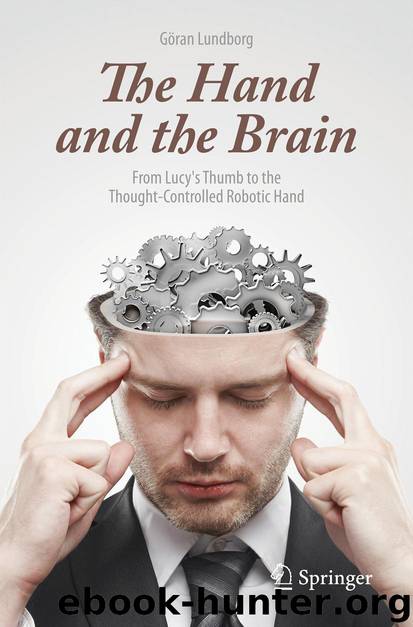The Hand and the Brain by Göran Lundborg

Author:Göran Lundborg
Language: eng
Format: epub
Publisher: Springer London, London
The patient now has to learn to understand the new language and reacquire the capacity to recognise and perceive the shapes and textures of items by touching them – like a newborn child touching objects around it for the first time. Tactile and visual impressions interact in newborns so that the child acquires a capacity to recognise and understand shapes by touching them, perhaps also using its lips to further optimise sensory information. An adult nerve-injured patient, due to reinnervation of incorrect cutaneous areas of the hand, usually loses the ability that he acquired as a newborn child to comprehend shapes and textures by touching them. Therefore, after nerve repair, adult patients must participate in specific sensory re-education programmes to recover as much as possible of their hand’s tactile discriminative functions.
In the sensory relearning programme, the patient explores the shape and texture of objects of increasing ‘difficulty’ by touching them – alternately with the eyes open and closed. The visual sense explains what the hand just touched, thus recoding for the sense of touch [34–38]. By training on objects of continuously increasing complexity, it is possible to train the brain’s capacity to understand shapes and textures, but an adult patient usually never recovers the original refined tactile sensibility in the hand after repair of an injured nerve.
While adults have difficulties learning the new sensory language after nerve repair, young children behave quite differently. Children up to 10–12 years of age usually have a complete restoration of all sensory functions in the hand including the fine discriminative capacities. They learn to understand the new ‘sensory language’, just as children moving to a foreign country can easily learn to speak and understand a second language [39].
There is an obvious analogy between the capacity to recover normal sensibility in the hand after nerve repair and the capacity to acquire a second language with correct grammar and pronunciation, as related to age [39]. In both situations, there seems to be a critical limit at the age of around 10–12 years, followed by a rapid decline during the teens and the adult stage. Interestingly, it has recently been demonstrated that the excellent sensory recovery that is usually obtained after nerve repair in children below the age of 12 persists even at a follow-up 30 years later when the child has reached adulthood [40, 41], much like the lifelong ability to speak a second language after learning it at a very young age.
Download
This site does not store any files on its server. We only index and link to content provided by other sites. Please contact the content providers to delete copyright contents if any and email us, we'll remove relevant links or contents immediately.
| Automotive | Engineering |
| Transportation |
Whiskies Galore by Ian Buxton(41720)
Introduction to Aircraft Design (Cambridge Aerospace Series) by John P. Fielding(33017)
Small Unmanned Fixed-wing Aircraft Design by Andrew J. Keane Andras Sobester James P. Scanlan & András Sóbester & James P. Scanlan(32685)
Craft Beer for the Homebrewer by Michael Agnew(18082)
Turbulence by E. J. Noyes(7895)
The Complete Stick Figure Physics Tutorials by Allen Sarah(7265)
Kaplan MCAT General Chemistry Review by Kaplan(6823)
The Thirst by Nesbo Jo(6759)
Bad Blood by John Carreyrou(6477)
Modelling of Convective Heat and Mass Transfer in Rotating Flows by Igor V. Shevchuk(6354)
Learning SQL by Alan Beaulieu(6159)
Weapons of Math Destruction by Cathy O'Neil(6085)
Man-made Catastrophes and Risk Information Concealment by Dmitry Chernov & Didier Sornette(5878)
Digital Minimalism by Cal Newport;(5588)
Life 3.0: Being Human in the Age of Artificial Intelligence by Tegmark Max(5405)
iGen by Jean M. Twenge(5326)
Secrets of Antigravity Propulsion: Tesla, UFOs, and Classified Aerospace Technology by Ph.D. Paul A. Laviolette(5237)
Design of Trajectory Optimization Approach for Space Maneuver Vehicle Skip Entry Problems by Runqi Chai & Al Savvaris & Antonios Tsourdos & Senchun Chai(4957)
Electronic Devices & Circuits by Jacob Millman & Christos C. Halkias(4865)
